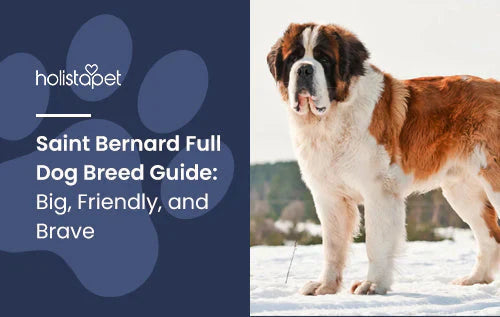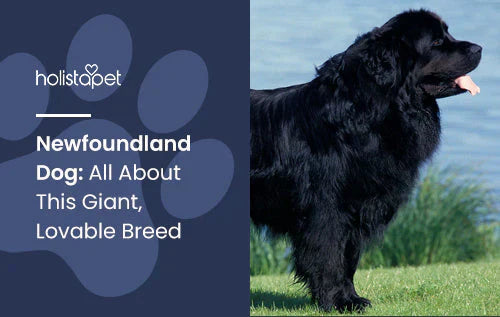Originating from the mountains of Switzerland as a guard dog of a hospice center, Saint Bernards are now known as a giant and adored pet with plenty of love to give. They are large in build and have equally large hearts. Let's take a closer look at this iconic canine breed and its rich history in society.
St Bernard Characteristics (Physical)
According to the American Kennel Club, the Great St. Bernard is among the top 5 largest dogs, just right behind the Bullmastiff and the Neapolitan Mastiff. Structurally, a St Bernard stands tall with a large head and muscular body. They have short, floppy ears, a massive square muzzle, and a set of deep brown eyes, creating a mask-like look on their face.

Size
St Bernards very big dogs, standing at about 26-30 inches tall at the shoulder. Along with their towering stance, they are rather hefty in weight. Male Bernards can weigh between 140-180 pounds, and female Bernards can range between 120 and 140 pounds.
Personality
Despite its intimidating and massive exterior, St Bernards are a kind, gentle, and patient breed. They make perfect family pets because they enjoy spending time inside with people and require very little physical activity. In fact, they can survive off of short daily walks and access to a small yard.
Exercise
Even though the St Bernard is a large breed, they only require a moderate amount of exercise. Going for daily walks or scheduling 30-minutes of playtime a day should suffice and keep your dog happy and healthy. This breed enjoys life the most when they can spend time with their owners.
Training a St Bernard
No matter the breed, it is always best to start training and socialization with other dogs at an early age. Since these dogs are large, it is important to train them early on via puppy training classes or obedience training, so they are easier to manage later in life. Although Bernards are friendly dogs, they may not be aware of their power and how overwhelming it can be around small children.
St Bernard Dog Breed History
The earliest ancestors of the St Bernard were the Talhund and Bauerhund. As time went on, the breed began to evolve into the St Bernard breed. This new brave and powerful breed became the guards and rescuers of any travelers stuck in the Great Saint Bernard Pass. Before being officially named the St Bernard in 1880, this dog went by several different names, such as Monastery Dogs, Sacred Dogs, Alpendogs, and Alpine Mastiffs.
One of the most famous life-saving dogs of this breed was named Barry der Menschenretter. Barry, born in 1800, rescued over 40 people in his lifetime. After his passing, the Natural History Museum of Berne in Switzerland placed the fur of Barry der Menschenretter on display to showcase his courage and fearlessness.

Common St Bernard Health Problems
Every dog breed is prone to experiencing health problems, many of which can be hereditary. Because of its size, many St Bernards often experience joint and muscle problems. Other common health issues include allergies, eye problems, and stomach issues.
Hip & Elbow Dysplasia
Hip dysplasia is a condition that can be inherited or result from injury or obesity. This condition occurs when the thighbone doesn't fit properly in the hip socket. Over time, the misalignment of the hip joint can lead to bone damage, significant pain, and lameness in your St Bernard's hind legs. As your dog ages, it is best to take your dog to the vet regularly if you notice any stiffness or hesitation when they walk.
Dilated Cardiomyopathy
Dilated cardiomyopathy is a heart condition in which the heart muscle becomes very thin and weak. Specifically, the muscle wall of the left ventricle becomes thinner, allowing the blood pressure to increase inside the heart, causing the thin walls to expand, which results in an enlarged heart.
Cataracts
Cataracts are a condition in which an opacity on the lens of the eyes causes difficulty with seeing, giving your dog hazy or cloudy vision. This eye condition is usually an inherited disease and is more common in older dogs. This condition can lead to blindness if the cataracts are not removed through surgery.
Heatstroke
A common condition among St Bernard dogs is heatstroke. Although their double-coat allows for excellent protection in snowy weather, it doesn't work so well in the heat. To avoid your dog from suffering a heat stroke, never keep them outside on a hot day for too long, and try to take them out for a walk during the cooler parts of the day.
Gastric Dilation-Volvulus (GDV)
Gastric dilation-volvulus, also known as bloat, is a life-threatening condition commonly affecting deep-chested dogs such as the St Bernard. GDV occurs when the stomach fills with gas, causing a "bloat" to form. Bloating can be a serious issue when the dog cannot get rid of the excess gas through vomiting or belching, making it difficult for normal blood flow to the heart.

How to Care for a St Bernard
These dogs are relatively low maintenance. They only need weekly brushing alongside a moderate amount of exercise, are easy to train, and are extremely friendly. This breed only needs about 30 minutes of playtime or a good walk daily to stay healthy. In addition to a steady diet, maintaining a daily exercise routine is important to prevent obesity. Overweight dogs can sometimes have more serious health issues that can affect their heart and digestion.
Nutrition and Feeding for a St Bernard
As with any larger dog breed, they require more food to sustain themselves. The recommended serving amount for a St Bernard is about five to six cups of high-quality dog food daily, divided into two meals. Of course, the amount of food your St Bernard needs depends on their weight, age, and overall size.
Related: Organic Dog Food Vs Non Organic [In-Depth Comparison]
Coat Color and Grooming
St Bernards have two types of coats: short-haired and long-haired. Short-haired types have a dense, smooth coat, while the long-haired Bernard has a slightly wavy coat. Brushing your Bernard's coat a few times a week is important to remove any loose hairs and prevent any mats or tangles.
Because of their size, it is recommended to bathe your Bernard buddy outside. Unless you have a walk-in shower, bathing your pup with the hose and a bucket should do the trick. As for shampoo, use a whitening shampoo to brighten and clean their coat.
St Bernard Dog Rescue Groups
If you are in the market for a magnificent St Bernard, there are several rescue groups you can turn to to help you rescue your very own. Sunny Saints St. Bernard Rescue is an organization based in Southern California dedicated to finding loving homes for the breed. Since 2010, the Sunny Saints have rescued over 700 St. Bernards and counting. The Sunny Saints have been featured on an episode of Cesar Milan's Cesar911.
St Bernard Rescue Foundation, Inc. is a foundation committed to rescuing abandoned and mistreated dogs and matching them with caring new homes. Founded in 1999, the SBRF has been finding homes for St Bernards all across the United States.
St Bernard Dog Breed Organizations
The most prominent breed organization is the SBCA. Established in 1888, the Saint Bernard Club of America is dedicated to withholding the "perfect" standard of the St Bernard breed, providing resources and information for all owners and enthusiasts. The SBCA also focuses on creating a passionate community for the betterment and promotion of the breed.

Final Thoughts - St Bernard
The St Bernard is truly a remarkable breed, known for its massive size, gentle nature, and rich history of bravery and service. These dogs make wonderful companions for families, provided they have the space and time to care for such a large and affectionate animal. Whether you're looking for a dedicated guardian or a devoted friend, this is a breed that embodies love and companionship in its most noble form.







![Probiotics For Dogs [Soft Chews] - HolistaPet](http://www.holistapet.com/cdn/shop/files/Probiotic-Infographic-1_472d7a29-e30c-435a-9638-1365d8c3a9f9.jpg?v=1725384841&width=104)



























Leave a comment
All comments are moderated before being published.
This site is protected by hCaptcha and the hCaptcha Privacy Policy and Terms of Service apply.